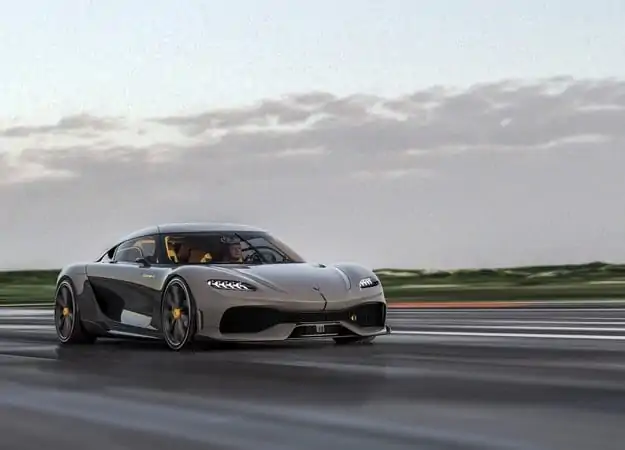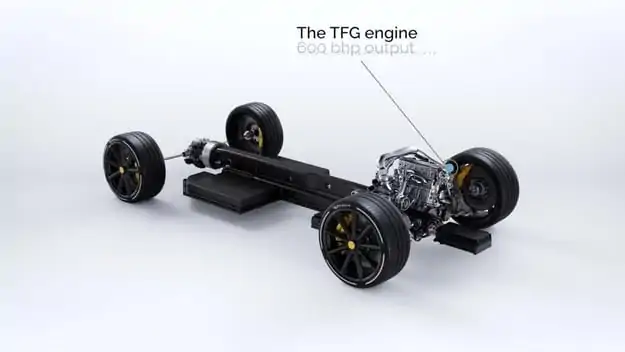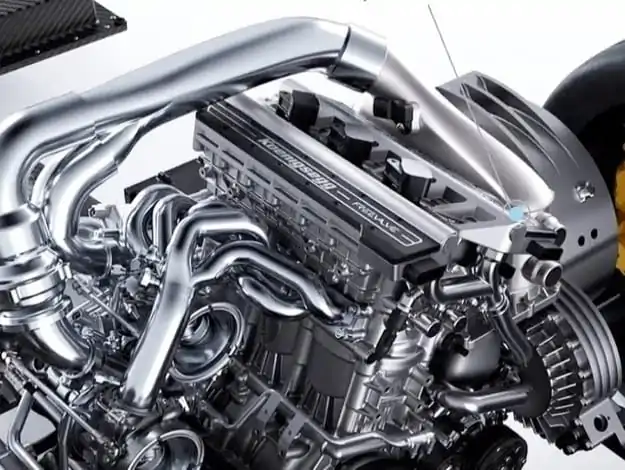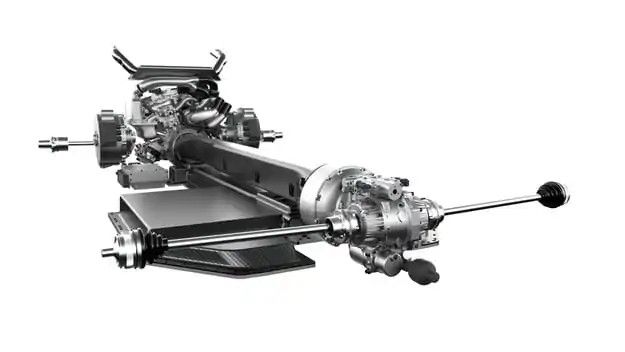
What is an internal combustion engine capable of?
When it comes to Koenigsegg, everything seems to come from another planet. The new model of the Swedish brand called Gemera is no different from this formulation - a four-seater GT model with hybrid drive, system power of 1700 hp, a top speed of 400 km / h and acceleration to 100 km / h in 1,9. seconds. Although supercars are no longer so rare in the modern world, the Gemera still has some distinctive features. And the most distinctive of these features is the car's engine.
Koenigsegg calls it the Tiny Friendly Giant, or TNG for short. And there is a reason - the TFG has a displacement of two liters, three cylinders (!), two turbochargers and 600 hp. at 300 hp per litre, this unit achieves the maximum power ever offered by a production engine. The company claims that in terms of technology, the TFG is "ahead of any other three-cylinder engine on the market today." In fact, they are absolutely right - the next three-cylinder engine is the 268 hp used by Toyota in the GR Yaris.
The most unusual technology in the TFG is the camless valve timing system. Instead, the engine uses a system developed by Koenigsegg subsidiary Freevalve, with pneumatic actuators for each valve.

In fact, the "little friendly giant" was developed specifically for Gemera. The Swedish company wanted to create something compact, lightweight, but with great power. In addition, the general design philosophy of the drive has changed, and, unlike the hybrid Gegera Regera, most of the power is provided by electric motors. The internal combustion engine has an additional contribution to drive and battery charging.
Before deciding to create a three-cylinder engine in Koenigsegg, they thought a lot. However, this decision will not be made unambiguously in an exclusive car. Nevertheless, the search for such qualities as compactness and lightness prevails and leads to the creation of the most extreme engine in the world, in terms of not only a liter, but also a “cylinder”.
The engine configuration, however, has fairly large cylinders and sounds quite catchy, with the typical low-frequency timbre of three-cylinder engines, but much more breathy. Christian von Koenigsegg, the founder of the company, said of him: "Imagine a Harley, but with a different cylinder." Although it has a fairly large bore of 95mm and a stroke of 93,5mm, the TFG loves high revs. Its maximum power is reached at 7500 rpm and the tachometer red zone starts at 8500 rpm. Here, alchemy consists of expensive materials that provide lightness (speed) and strength (high pressure of the combustion process). Therefore, high speeds are accompanied by an incredible torque of 600 Nm.

Cascade turbocharging
The answer to the question of exactly how two turbochargers can be connected in a three-cylinder configuration is the cascade. A similar system used the iconic Porsche 80 in the 959s, which has similarities as two three-cylinder engines are filled with a small and a large turbocharger. However, TFG has a new interpretation on the subject. Each of the engine cylinders has two exhaust valves, one of which is responsible for filling the small turbocharger, and the other for the large turbocharger. At low revs and loads, only the three valves that feed gases to the small turbocharger open. At 3000 rpm, the second valves begin to open, directing the gases into the large turbocharger. However, the engine is so high-tech that in terms of its parameters, even in the “atmospheric” version, it can reach 280 hp. The reason lies in the same Freevalve valve technology. One of the reasons why a 2000 cc engine CM has three cylinders, is the fact that a three-cylinder engine is more efficient in terms of turbocharging, since there is no mutual damping of gas pulsations, as in a four-cylinder engine.
And pneumatic opening valves
Thanks to the Freevalve system, each valve moves individually. It can be opened independently with a specific duration, starting torque and stroke. At low load, only one opens, allowing for higher airflow and better fuel mixing. Thanks to the ability to precisely control each of the valves, there is no need for a throttle valve, and each of the cylinders can be turned off if necessary (in partial load modes). The flexibility of operation allows the TFG to switch from conventional Otto to Miller operation with increased duty cycle and higher efficiency. And this is not the most impressive - with the help of "blowing" from the turbo units, the engine can switch to two-stroke mode up to about 3000 rpm. According to Christian von Koenigseg at 6000 rpm in this mode it will sound like a six-cylinder. However, at 3000 rpm, the device switches back to four-stroke mode because there is not enough time for gas exchange at high speeds.

Artificial Intelligence
Koenigsegg, on the other hand, is working with SparkCognition, an American artificial intelligence company that develops artificial intelligence management software for Freevalve engines like TFG. Over time, the system will learn how to best control the valves, and the various ways of conducting the combustion process. The control system and the Freevalve system allow you to change the volume and timbre of the engine with different opening of the exhaust valves. He is also responsible for the ability to warm up the engine faster and reduce emissions. Thanks to the electric motor-generator at a very low temperature, the crankshaft engine rotates for about 10 cycles (within 2 seconds), at which the temperature of the compressed air in the cylinders reaches 30 degrees. During heating, the suction valve opens with a small stroke and there is a turbulent circulation of air and fuel around the exhaust valve, which improves evaporation.
Fuel also makes an important contribution to achieving high engine power. In fact, TFG is a Flex Fuel engine, that is, it can run on both gasoline and alcohol (ethanol, butanol, methanol) and mixtures in different proportions. The alcohol molecules contain oxygen and thus provide what is needed to burn the hydrocarbon portion. Of course, this means higher fuel consumption, but it is provided more easily than a large amount of air. Alcohol blends also provide a cleaner combustion process and less particulate matter is released during the combustion process. And if ethanol is extracted from plants, it can also provide a carbon-neutral process. When running on gasoline, the engine power is 500 hp. Recall that the combustion control in the TFG is so high-tech that it manages to extract almost the maximum possible from the fuel without detonation - the most neuralgic combustion zone at such a high turbo pressure. It is truly unique with a 9,5:1 compression ratio and very high filling pressure. We can only guess how exactly the cylinder head is attached to the block, and the strength of the latter, given the enormous working pressure of the combustion process, to some extent this may explain the presence of spherical, column-like shapes in its architecture.

Of course, the complex Freevalve system costs more than conventional mechanical valve actuators, but less raw materials are used to create the engine, which to some extent compensates for both cost and weight. Thus, in general, the cost of a high-tech TFG is two times lower than that of an eight-cylinder five-liter turbocharger company.
Unique Gemera Drive
The rest of the Gemera drivetrain is also unique and unusual. The TFG is located behind the passenger compartment and controls the front axle using a unique direct drive system without a gearbox with gears, but with two hydraulic clutches on each axis. The system is called HydraCoup, and at a certain speed, the hydraulic clutch locks and direct drive. This is due to the fact that the internal combustion engine is also directly connected to an electric motor-generator with a capacity of up to 400 hp. power respectively up to 500 Nm.
The HydraCoup converts a total of 1100 Nm TFG and an electric motor, doubling the torque to 3000 rpm. Added to all this is the torque of each of the two electric motors that drive one rear wheel with 500 hp. each and, accordingly, 1000 Nm. Thus, the total system power is 1700 hp. Each of the electric motors has a voltage of 800 volts. The car's battery is also unique. It has a voltage of 800 volts and a power of only 15 kWh, has a discharge (output) power of 900 kW and a charging power of 200 kW. Each of its cells is individually controlled in terms of temperature, state of charge, "health", and they are all combined into a common carbon body, located in the safest place - under the front seats and in the carbon-aramid drive tunnel. All this will mean that after a few more vigorous accelerations, the car will have to move slowly for a while in order for the TFG to charge the battery.
All the unusual layout is based on the philosophy of a company producing cars with an intermediate rear engine. Koenigsegg has not yet planned a clean electric car, because they believe that the technology in this area is not sufficiently developed and makes cars very heavy. To reduce carbon dioxide emissions, the company uses alcoholic fuel and an internal combustion engine.
Gemera's 800-volt electrical system provides up to 50 km of electricity and a speed of 300 km/h. For recreation up to 400 km/h, the responsibility of TFG. In hybrid mode, the car can travel another 950 km, which indicates a fairly high efficiency of the system - the TFG itself consumes about 20 percent less than a modern two-liter engine. with conventional variable gas distribution. And the stability of the car is also ensured by the rear-wheel steering system, electric torque vectoring at the rear, and mechanical torque vectoring at the front (using additional wet clutches in the front-wheel drive mechanisms, next to the hydraulic converters). The Gemera thus became a vehicle with all-wheel drive, four-wheel steering and torque vectoring. Added to all this is the regulation of body height.
Although this engine is unique in nature, it shows that it can guide the development of an internal combustion engine. The same debate is taking place in Formula 1 - the search for efficiency will likely focus on synthetic fuels and the two-stroke mode of operation.